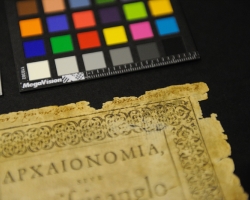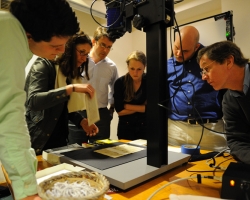Spectral Imaging and Shakespeare

In 1938, the Folger Shakespeare Library acquired a copy of William Lambarde’s Archaionomia (1568), a treatise on Anglo-Saxon law. This copy is a treasure of the library, as it contains what might be the seventh genuine signature of William Shakespeare on the title-page. Over spring break, members of the Lazarus Project and SMB Honors students met in Washington, D.C. to collect and process multispectral images of this alleged signature. Check out the following post and story about the project: http://collation.folger.edu/2012/03/spectral-imaging-of-shakespeares-seventh-signature/ and “UM Students Use Technology to Analyze Shakespeare’s Signature”
Spectral Imaging Analysis of Skipwith Letters
The Skipwith Revolutionary War Letters were donated by Miss Kate Skipwith and Mrs. Mary Skipwith Buie, General Nathanael Greene’s great-granddaughters. They were damaged and partly illegible, but honors students worked with multispectral imaging technology to illuminate the text.

Honors students Marie Wicks, Danielle Thorton, and Devon Emig watch as a document is prepared for spectral imaging.
A watermark (pictured above, right) was found on the document by students in Dr. Heyworth’s Honors “Image, Text, and Technology” course. The image on the left shows the watermark as it appears to the naked eye while and the image on the right shows the processed multispectral image displaying the watermark.
“Les Eschéz d’Amours” Dresden Project
“Les Eschéz d’Amours” (The Chess of Love) is a 14th century, 30,000+ line Middle French epic poem heavily damaged during the Allied bombings of Dresden and thought to be unrecoverable. In 2009, the poem sparked the inaugural project of the Lazarus Project. Working in Dresden that summer, members of the Lazarus Project and three SMB Honors students collected and began to process multispectral images of the manuscript, recovering illuminations, an armorial achievement, and text.



